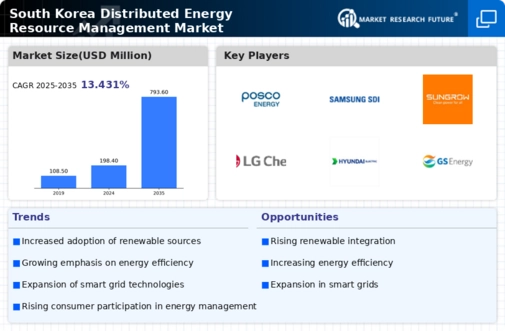Government Incentives and Policies
The South Korean government actively promotes the distributed energy-resource-management market through various incentives and policies. These initiatives include subsidies for renewable energy installations and tax benefits for energy-efficient technologies. In 2025, the government aims to increase the share of renewable energy in the national energy mix to 30% by 2030. This ambitious target is likely to drive investments in distributed energy resources, as stakeholders seek to align with national objectives. Furthermore, the regulatory framework is evolving to support decentralized energy systems, which could enhance market participation and innovation. As a result, the distributed energy-resource-management market is expected to experience robust growth, driven by favorable government actions and a commitment to sustainable energy solutions.
Corporate Sustainability Initiatives
Many corporations in South Korea are adopting sustainability initiatives that directly impact the distributed energy-resource-management market. Companies are increasingly recognizing the importance of reducing their carbon footprints and enhancing energy efficiency. In 2025, it is estimated that over 60% of large enterprises will implement renewable energy solutions as part of their corporate strategies. This shift not only aligns with global sustainability trends but also meets the growing consumer demand for environmentally responsible practices. As businesses invest in distributed energy resources, they contribute to the overall growth of the market. Furthermore, corporate partnerships with technology providers and energy service companies are likely to foster innovation and accelerate the deployment of distributed energy solutions.
Rising Energy Demand and Urbanization
The increasing energy demand in urban areas of South Korea is a significant driver for the distributed energy-resource-management market. As urbanization accelerates, the need for reliable and sustainable energy solutions becomes more pressing. In 2025, urban areas are expected to account for over 80% of the national energy consumption. This trend necessitates the adoption of distributed energy resources to meet the growing demand while minimizing environmental impacts. Additionally, urban centers are increasingly investing in smart grid technologies, which facilitate the integration of distributed energy systems. This shift towards localized energy solutions is likely to enhance the resilience of urban energy infrastructure, thereby propelling the distributed energy-resource-management market forward.
Technological Innovations in Energy Storage
Technological advancements in energy storage systems are playing a crucial role in the distributed energy-resource-management market. In South Korea, the development of high-capacity batteries and innovative storage solutions is enabling more efficient energy management. For instance, the market for energy storage systems is projected to grow at a CAGR of 15% from 2025 to 2030. These innovations allow for better integration of renewable energy sources, facilitating energy supply during peak demand periods. Moreover, improved storage technologies enhance grid stability and reliability, which are essential for the successful deployment of distributed energy resources. Consequently, the ongoing evolution of energy storage technologies is likely to bolster the distributed energy-resource-management market significantly.
Consumer Awareness and Demand for Clean Energy
Consumer awareness regarding environmental issues and the demand for clean energy are increasingly influencing the distributed energy-resource-management market in South Korea. As public consciousness about climate change grows, consumers are more inclined to support renewable energy initiatives. Surveys indicate that approximately 70% of South Koreans are willing to pay a premium for clean energy options. This shift in consumer behavior is prompting energy providers to enhance their offerings and invest in distributed energy resources. Additionally, educational campaigns and community engagement efforts are likely to further elevate consumer interest in sustainable energy solutions. Consequently, the rising demand for clean energy is expected to significantly drive the growth of the distributed energy-resource-management market.


















Leave a Comment